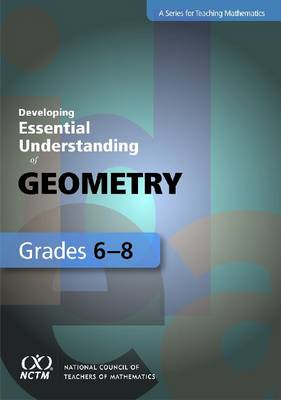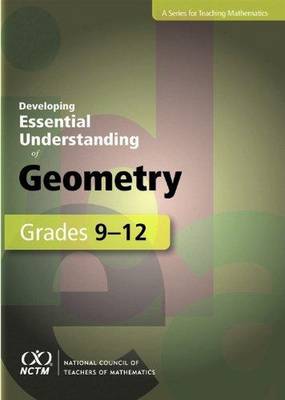Developing Essential Understanding
2 total works
Developing Essential Understanding of Geometry for Teaching Mathematics in Grades 6-8
by Nathalie Sinclair, David Pimm, and Melanie Skelin
Published 25 June 2012
Why are there so many formulas for area and volume, and why do some of them look alike? Why does one quadrilateral have no special name while another has several, like square, rectangle, rhombus, and parallelogram-and why are all these names useful?
How much do you know ... and how much do you need to know?
Helping your students develop a robust understanding of geometry requires that you understand this mathematics deeply. But what does that mean? This book focuses on essential knowledge for teachers about geometry. It is organized around four big ideas, supported by multiple smaller, interconnected ideas-essential understandings. Taking you beyond a simple introduction to geometry, the book will broaden and deepen your mathematical understanding of one of the most challenging topics for students-and teachers. It will help you engage your students, anticipate their perplexities, avoid pitfalls, and dispel misconceptions. You will also learn to develop appropriate tasks, techniques, and tools for assessing students' understanding of the topic.
How much do you know ... and how much do you need to know?
Helping your students develop a robust understanding of geometry requires that you understand this mathematics deeply. But what does that mean? This book focuses on essential knowledge for teachers about geometry. It is organized around four big ideas, supported by multiple smaller, interconnected ideas-essential understandings. Taking you beyond a simple introduction to geometry, the book will broaden and deepen your mathematical understanding of one of the most challenging topics for students-and teachers. It will help you engage your students, anticipate their perplexities, avoid pitfalls, and dispel misconceptions. You will also learn to develop appropriate tasks, techniques, and tools for assessing students' understanding of the topic.
Developing Essential Understanding of Geometry for Teaching Mathematics in Grades 9-12
by Nathalie Sinclair, David Pimm, and Melanie Skelin
Published 5 July 2012
Why does it matter whether we state definitions carefully when we all know what particular geometric figures look like? What does it mean to say that a reflection is a transformation-a function? How does the study of transformations and matrices in high school connect with later work with vector spaces in linear algebra?
How much do you know... and how much do you need to know?
Helping your students develop a robust understanding of geometry requires that you understand this mathematics deeply. But what does that mean?
This book focuses on essential knowledge for teachers about geometry. It is organised around four big ideas, supported by multiple smaller, interconnected ideas-essential understandings. Taking you beyond a simple introduction to geometry, the book will broaden and deepen your mathematical understanding of one of the most challenging topics for students-and teachers. It will help you engage your students, anticipate their perplexities, avoid pitfalls, and dispel misconceptions. You will also learn to develop appropriate tasks, techniques, and tools for assessing students' understanding of the topic.
Focus on the ideas that you need to understand thoroughly to teach confidently.
Move beyond the mathematics you expect your students to learn. Students who fail to get a solid grounding in pivotal concepts struggle in subsequent work in mathematics and related disciplines. By bringing a deeper understanding to your teaching, you can help students who don't get it the first time by presenting the mathematics in multiple ways.
The Essential Understanding Series addresses topics in school mathematics that are critical to the mathematical development of students but are often difficult to teach. Each book in the series gives an overview of the topic, highlights the differences between what teachers and students need to know, examines the big ideas and related essential understandings, reconsiders the ideas presented in light of connections with other mathematical ideas, and includes questions for readers' reflection.
How much do you know... and how much do you need to know?
Helping your students develop a robust understanding of geometry requires that you understand this mathematics deeply. But what does that mean?
This book focuses on essential knowledge for teachers about geometry. It is organised around four big ideas, supported by multiple smaller, interconnected ideas-essential understandings. Taking you beyond a simple introduction to geometry, the book will broaden and deepen your mathematical understanding of one of the most challenging topics for students-and teachers. It will help you engage your students, anticipate their perplexities, avoid pitfalls, and dispel misconceptions. You will also learn to develop appropriate tasks, techniques, and tools for assessing students' understanding of the topic.
Focus on the ideas that you need to understand thoroughly to teach confidently.
Move beyond the mathematics you expect your students to learn. Students who fail to get a solid grounding in pivotal concepts struggle in subsequent work in mathematics and related disciplines. By bringing a deeper understanding to your teaching, you can help students who don't get it the first time by presenting the mathematics in multiple ways.
The Essential Understanding Series addresses topics in school mathematics that are critical to the mathematical development of students but are often difficult to teach. Each book in the series gives an overview of the topic, highlights the differences between what teachers and students need to know, examines the big ideas and related essential understandings, reconsiders the ideas presented in light of connections with other mathematical ideas, and includes questions for readers' reflection.

